Operational Management Analysis: Leadership, Roles, and Strategies
VerifiedAdded on 2020/11/12
|13
|3917
|383
Report
AI Summary
This report provides a comprehensive analysis of leadership and management within the context of operational management, using Marks & Spencer as a case study. It begins by differentiating between leaders and managers, outlining their respective roles and characteristics, and then explores how they handle various situations such as employee engagement and conflict resolution. The report delves into different leadership theories, including situational and contingency leadership, evaluating their strengths and weaknesses. It also examines key approaches to operational management, such as lean production and just-in-time systems, and discusses their importance in achieving business objectives. The report concludes by highlighting factors within the business environment that impact operational management and decision-making, providing a holistic view of the subject.
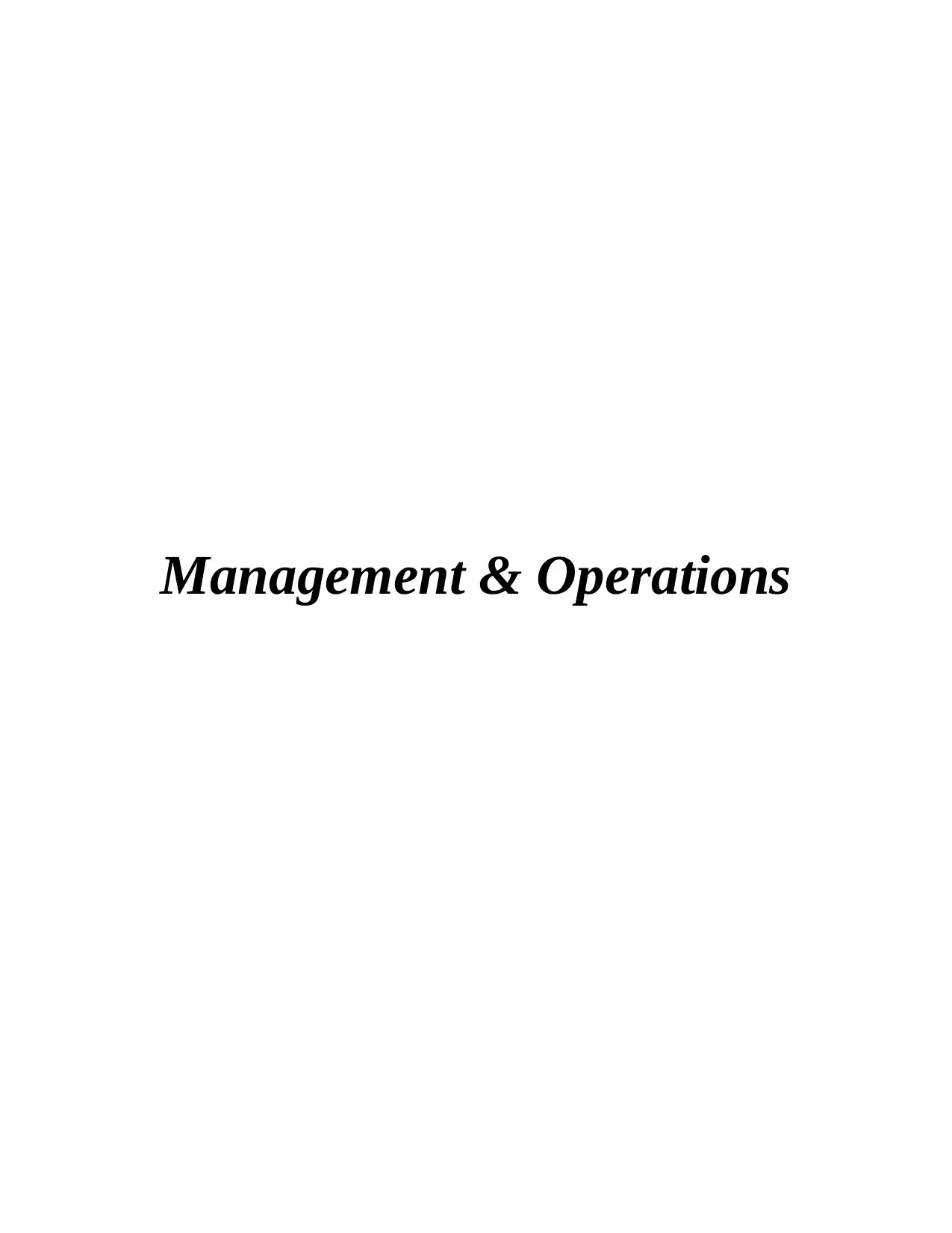
Management & Operations
Paraphrase This Document
Need a fresh take? Get an instant paraphrase of this document with our AI Paraphraser
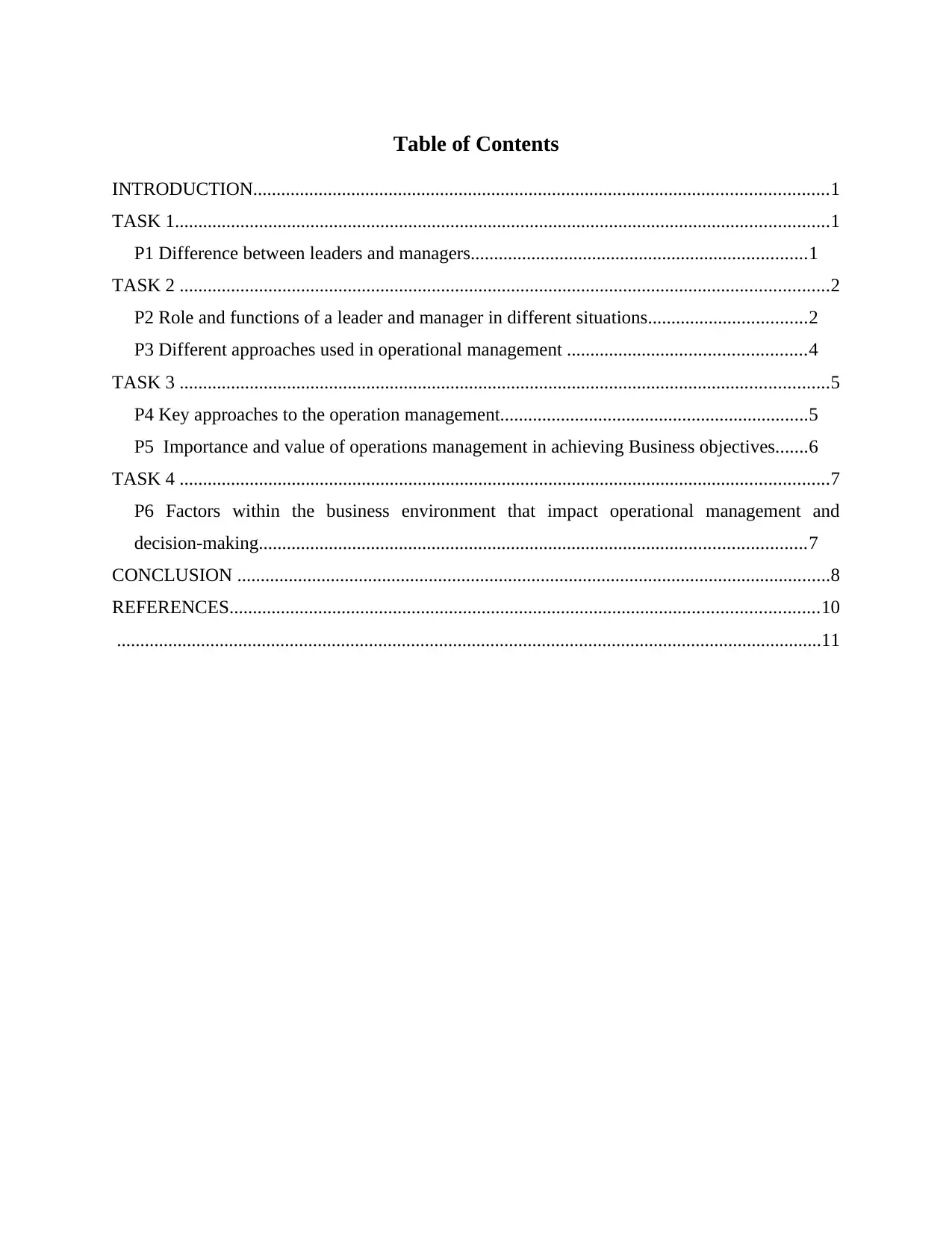
Table of Contents
INTRODUCTION...........................................................................................................................1
TASK 1............................................................................................................................................1
P1 Difference between leaders and managers........................................................................1
TASK 2 ...........................................................................................................................................2
P2 Role and functions of a leader and manager in different situations..................................2
P3 Different approaches used in operational management ...................................................4
TASK 3 ...........................................................................................................................................5
P4 Key approaches to the operation management..................................................................5
P5 Importance and value of operations management in achieving Business objectives.......6
TASK 4 ...........................................................................................................................................7
P6 Factors within the business environment that impact operational management and
decision-making.....................................................................................................................7
CONCLUSION ...............................................................................................................................8
REFERENCES..............................................................................................................................10
.......................................................................................................................................................11
INTRODUCTION...........................................................................................................................1
TASK 1............................................................................................................................................1
P1 Difference between leaders and managers........................................................................1
TASK 2 ...........................................................................................................................................2
P2 Role and functions of a leader and manager in different situations..................................2
P3 Different approaches used in operational management ...................................................4
TASK 3 ...........................................................................................................................................5
P4 Key approaches to the operation management..................................................................5
P5 Importance and value of operations management in achieving Business objectives.......6
TASK 4 ...........................................................................................................................................7
P6 Factors within the business environment that impact operational management and
decision-making.....................................................................................................................7
CONCLUSION ...............................................................................................................................8
REFERENCES..............................................................................................................................10
.......................................................................................................................................................11
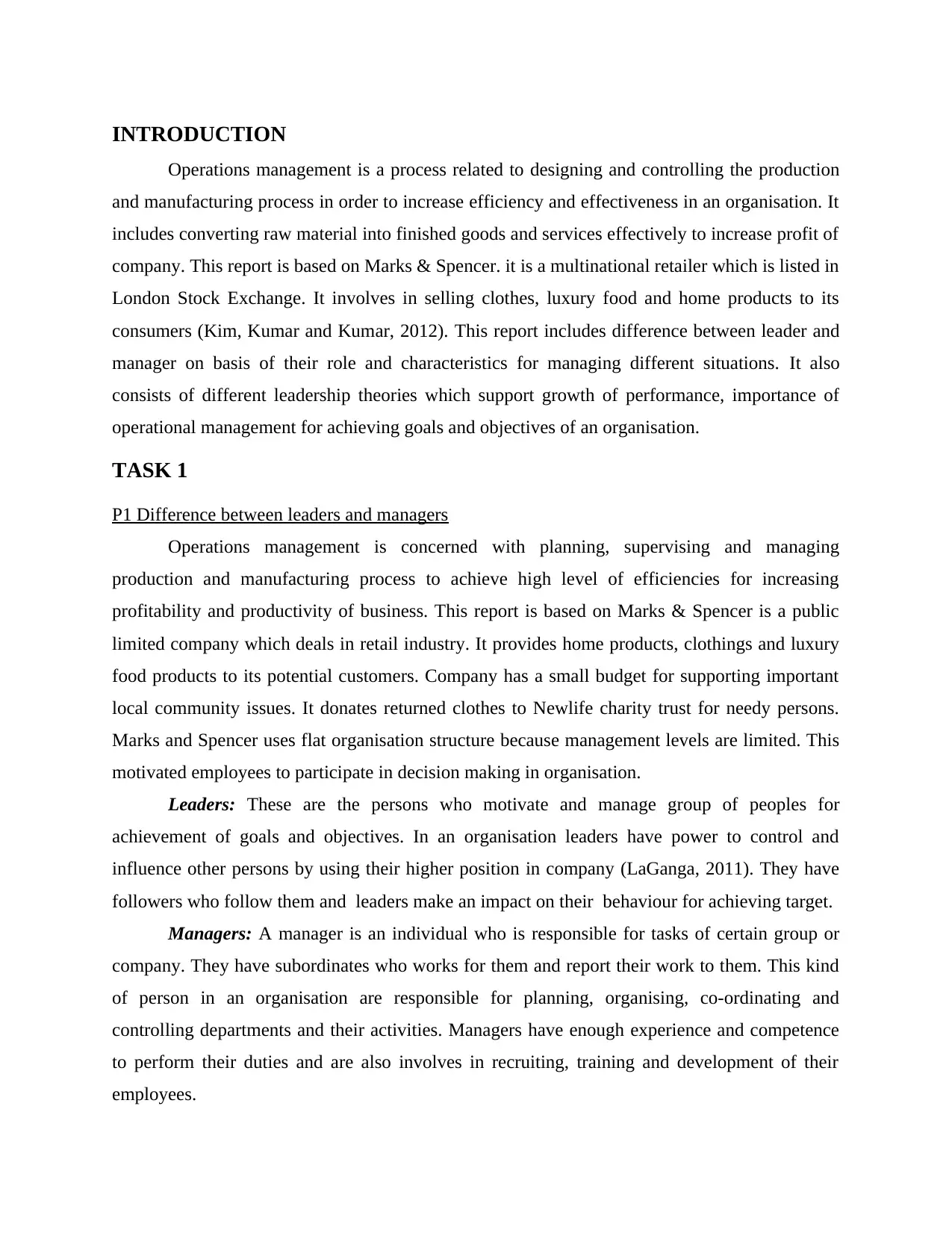
INTRODUCTION
Operations management is a process related to designing and controlling the production
and manufacturing process in order to increase efficiency and effectiveness in an organisation. It
includes converting raw material into finished goods and services effectively to increase profit of
company. This report is based on Marks & Spencer. it is a multinational retailer which is listed in
London Stock Exchange. It involves in selling clothes, luxury food and home products to its
consumers (Kim, Kumar and Kumar, 2012). This report includes difference between leader and
manager on basis of their role and characteristics for managing different situations. It also
consists of different leadership theories which support growth of performance, importance of
operational management for achieving goals and objectives of an organisation.
TASK 1
P1 Difference between leaders and managers
Operations management is concerned with planning, supervising and managing
production and manufacturing process to achieve high level of efficiencies for increasing
profitability and productivity of business. This report is based on Marks & Spencer is a public
limited company which deals in retail industry. It provides home products, clothings and luxury
food products to its potential customers. Company has a small budget for supporting important
local community issues. It donates returned clothes to Newlife charity trust for needy persons.
Marks and Spencer uses flat organisation structure because management levels are limited. This
motivated employees to participate in decision making in organisation.
Leaders: These are the persons who motivate and manage group of peoples for
achievement of goals and objectives. In an organisation leaders have power to control and
influence other persons by using their higher position in company (LaGanga, 2011). They have
followers who follow them and leaders make an impact on their behaviour for achieving target.
Managers: A manager is an individual who is responsible for tasks of certain group or
company. They have subordinates who works for them and report their work to them. This kind
of person in an organisation are responsible for planning, organising, co-ordinating and
controlling departments and their activities. Managers have enough experience and competence
to perform their duties and are also involves in recruiting, training and development of their
employees.
Operations management is a process related to designing and controlling the production
and manufacturing process in order to increase efficiency and effectiveness in an organisation. It
includes converting raw material into finished goods and services effectively to increase profit of
company. This report is based on Marks & Spencer. it is a multinational retailer which is listed in
London Stock Exchange. It involves in selling clothes, luxury food and home products to its
consumers (Kim, Kumar and Kumar, 2012). This report includes difference between leader and
manager on basis of their role and characteristics for managing different situations. It also
consists of different leadership theories which support growth of performance, importance of
operational management for achieving goals and objectives of an organisation.
TASK 1
P1 Difference between leaders and managers
Operations management is concerned with planning, supervising and managing
production and manufacturing process to achieve high level of efficiencies for increasing
profitability and productivity of business. This report is based on Marks & Spencer is a public
limited company which deals in retail industry. It provides home products, clothings and luxury
food products to its potential customers. Company has a small budget for supporting important
local community issues. It donates returned clothes to Newlife charity trust for needy persons.
Marks and Spencer uses flat organisation structure because management levels are limited. This
motivated employees to participate in decision making in organisation.
Leaders: These are the persons who motivate and manage group of peoples for
achievement of goals and objectives. In an organisation leaders have power to control and
influence other persons by using their higher position in company (LaGanga, 2011). They have
followers who follow them and leaders make an impact on their behaviour for achieving target.
Managers: A manager is an individual who is responsible for tasks of certain group or
company. They have subordinates who works for them and report their work to them. This kind
of person in an organisation are responsible for planning, organising, co-ordinating and
controlling departments and their activities. Managers have enough experience and competence
to perform their duties and are also involves in recruiting, training and development of their
employees.
⊘ This is a preview!⊘
Do you want full access?
Subscribe today to unlock all pages.

Trusted by 1+ million students worldwide
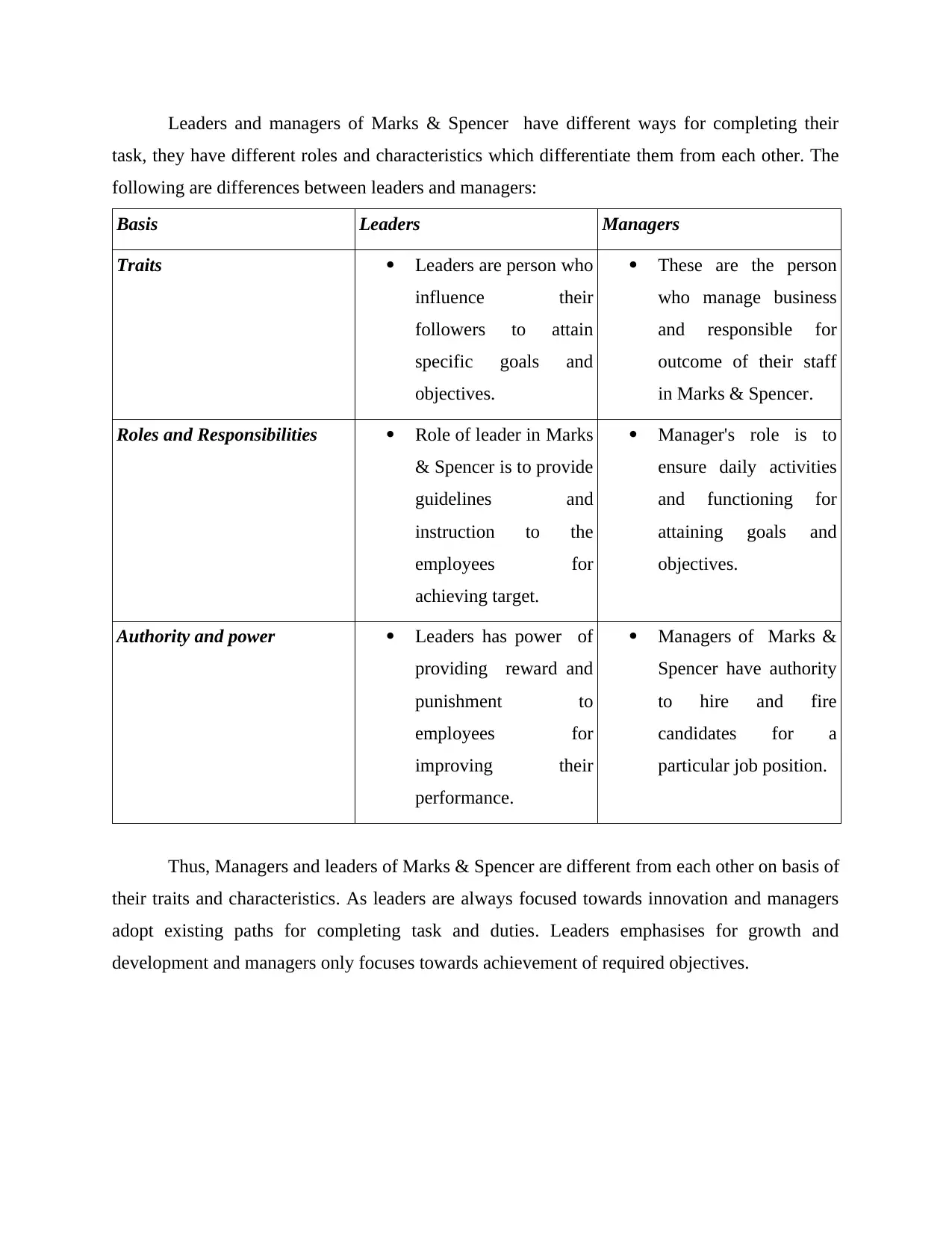
Leaders and managers of Marks & Spencer have different ways for completing their
task, they have different roles and characteristics which differentiate them from each other. The
following are differences between leaders and managers:
Basis Leaders Managers
Traits Leaders are person who
influence their
followers to attain
specific goals and
objectives.
These are the person
who manage business
and responsible for
outcome of their staff
in Marks & Spencer.
Roles and Responsibilities Role of leader in Marks
& Spencer is to provide
guidelines and
instruction to the
employees for
achieving target.
Manager's role is to
ensure daily activities
and functioning for
attaining goals and
objectives.
Authority and power Leaders has power of
providing reward and
punishment to
employees for
improving their
performance.
Managers of Marks &
Spencer have authority
to hire and fire
candidates for a
particular job position.
Thus, Managers and leaders of Marks & Spencer are different from each other on basis of
their traits and characteristics. As leaders are always focused towards innovation and managers
adopt existing paths for completing task and duties. Leaders emphasises for growth and
development and managers only focuses towards achievement of required objectives.
task, they have different roles and characteristics which differentiate them from each other. The
following are differences between leaders and managers:
Basis Leaders Managers
Traits Leaders are person who
influence their
followers to attain
specific goals and
objectives.
These are the person
who manage business
and responsible for
outcome of their staff
in Marks & Spencer.
Roles and Responsibilities Role of leader in Marks
& Spencer is to provide
guidelines and
instruction to the
employees for
achieving target.
Manager's role is to
ensure daily activities
and functioning for
attaining goals and
objectives.
Authority and power Leaders has power of
providing reward and
punishment to
employees for
improving their
performance.
Managers of Marks &
Spencer have authority
to hire and fire
candidates for a
particular job position.
Thus, Managers and leaders of Marks & Spencer are different from each other on basis of
their traits and characteristics. As leaders are always focused towards innovation and managers
adopt existing paths for completing task and duties. Leaders emphasises for growth and
development and managers only focuses towards achievement of required objectives.
Paraphrase This Document
Need a fresh take? Get an instant paraphrase of this document with our AI Paraphraser
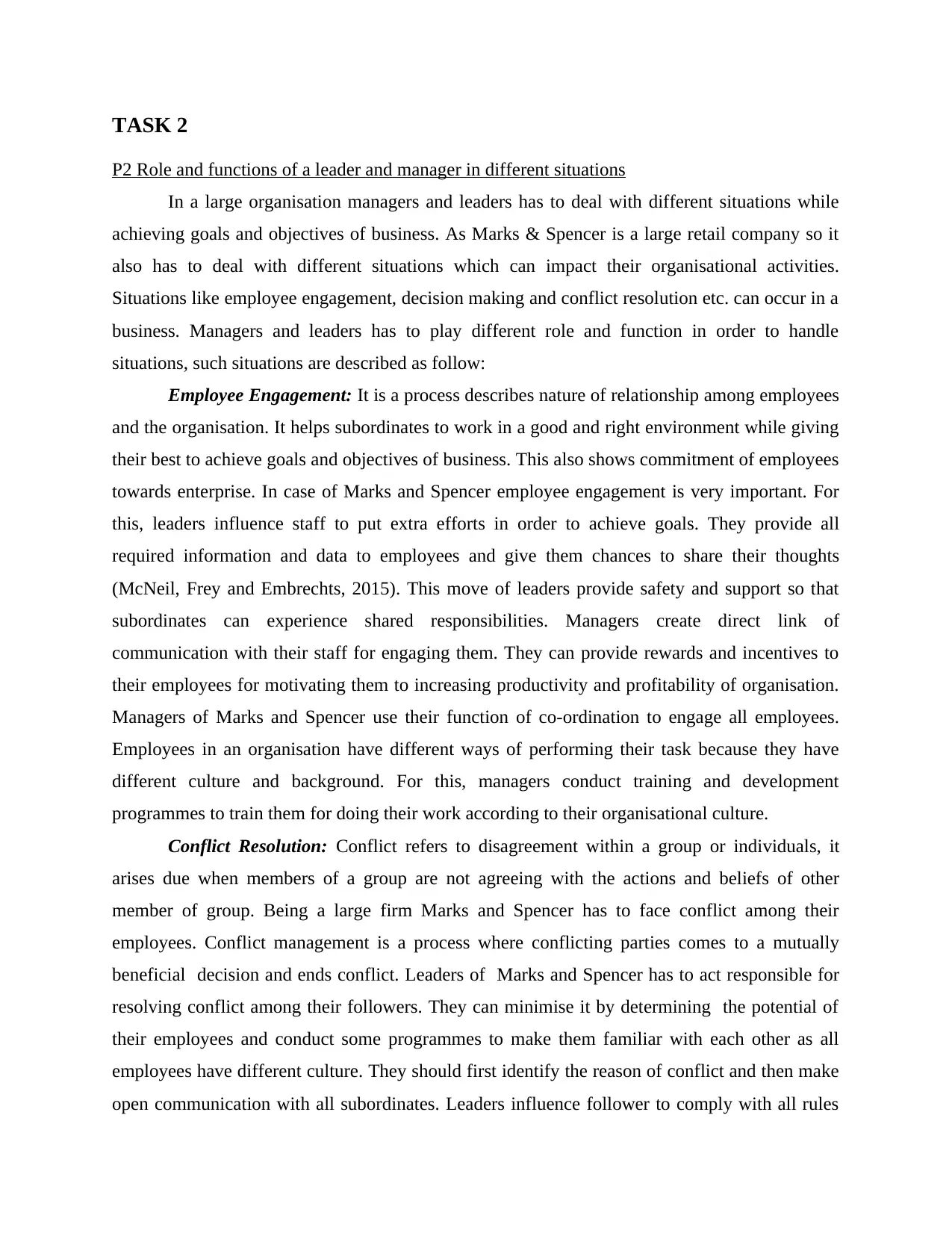
TASK 2
P2 Role and functions of a leader and manager in different situations
In a large organisation managers and leaders has to deal with different situations while
achieving goals and objectives of business. As Marks & Spencer is a large retail company so it
also has to deal with different situations which can impact their organisational activities.
Situations like employee engagement, decision making and conflict resolution etc. can occur in a
business. Managers and leaders has to play different role and function in order to handle
situations, such situations are described as follow:
Employee Engagement: It is a process describes nature of relationship among employees
and the organisation. It helps subordinates to work in a good and right environment while giving
their best to achieve goals and objectives of business. This also shows commitment of employees
towards enterprise. In case of Marks and Spencer employee engagement is very important. For
this, leaders influence staff to put extra efforts in order to achieve goals. They provide all
required information and data to employees and give them chances to share their thoughts
(McNeil, Frey and Embrechts, 2015). This move of leaders provide safety and support so that
subordinates can experience shared responsibilities. Managers create direct link of
communication with their staff for engaging them. They can provide rewards and incentives to
their employees for motivating them to increasing productivity and profitability of organisation.
Managers of Marks and Spencer use their function of co-ordination to engage all employees.
Employees in an organisation have different ways of performing their task because they have
different culture and background. For this, managers conduct training and development
programmes to train them for doing their work according to their organisational culture.
Conflict Resolution: Conflict refers to disagreement within a group or individuals, it
arises due when members of a group are not agreeing with the actions and beliefs of other
member of group. Being a large firm Marks and Spencer has to face conflict among their
employees. Conflict management is a process where conflicting parties comes to a mutually
beneficial decision and ends conflict. Leaders of Marks and Spencer has to act responsible for
resolving conflict among their followers. They can minimise it by determining the potential of
their employees and conduct some programmes to make them familiar with each other as all
employees have different culture. They should first identify the reason of conflict and then make
open communication with all subordinates. Leaders influence follower to comply with all rules
P2 Role and functions of a leader and manager in different situations
In a large organisation managers and leaders has to deal with different situations while
achieving goals and objectives of business. As Marks & Spencer is a large retail company so it
also has to deal with different situations which can impact their organisational activities.
Situations like employee engagement, decision making and conflict resolution etc. can occur in a
business. Managers and leaders has to play different role and function in order to handle
situations, such situations are described as follow:
Employee Engagement: It is a process describes nature of relationship among employees
and the organisation. It helps subordinates to work in a good and right environment while giving
their best to achieve goals and objectives of business. This also shows commitment of employees
towards enterprise. In case of Marks and Spencer employee engagement is very important. For
this, leaders influence staff to put extra efforts in order to achieve goals. They provide all
required information and data to employees and give them chances to share their thoughts
(McNeil, Frey and Embrechts, 2015). This move of leaders provide safety and support so that
subordinates can experience shared responsibilities. Managers create direct link of
communication with their staff for engaging them. They can provide rewards and incentives to
their employees for motivating them to increasing productivity and profitability of organisation.
Managers of Marks and Spencer use their function of co-ordination to engage all employees.
Employees in an organisation have different ways of performing their task because they have
different culture and background. For this, managers conduct training and development
programmes to train them for doing their work according to their organisational culture.
Conflict Resolution: Conflict refers to disagreement within a group or individuals, it
arises due when members of a group are not agreeing with the actions and beliefs of other
member of group. Being a large firm Marks and Spencer has to face conflict among their
employees. Conflict management is a process where conflicting parties comes to a mutually
beneficial decision and ends conflict. Leaders of Marks and Spencer has to act responsible for
resolving conflict among their followers. They can minimise it by determining the potential of
their employees and conduct some programmes to make them familiar with each other as all
employees have different culture. They should first identify the reason of conflict and then make
open communication with all subordinates. Leaders influence follower to comply with all rules
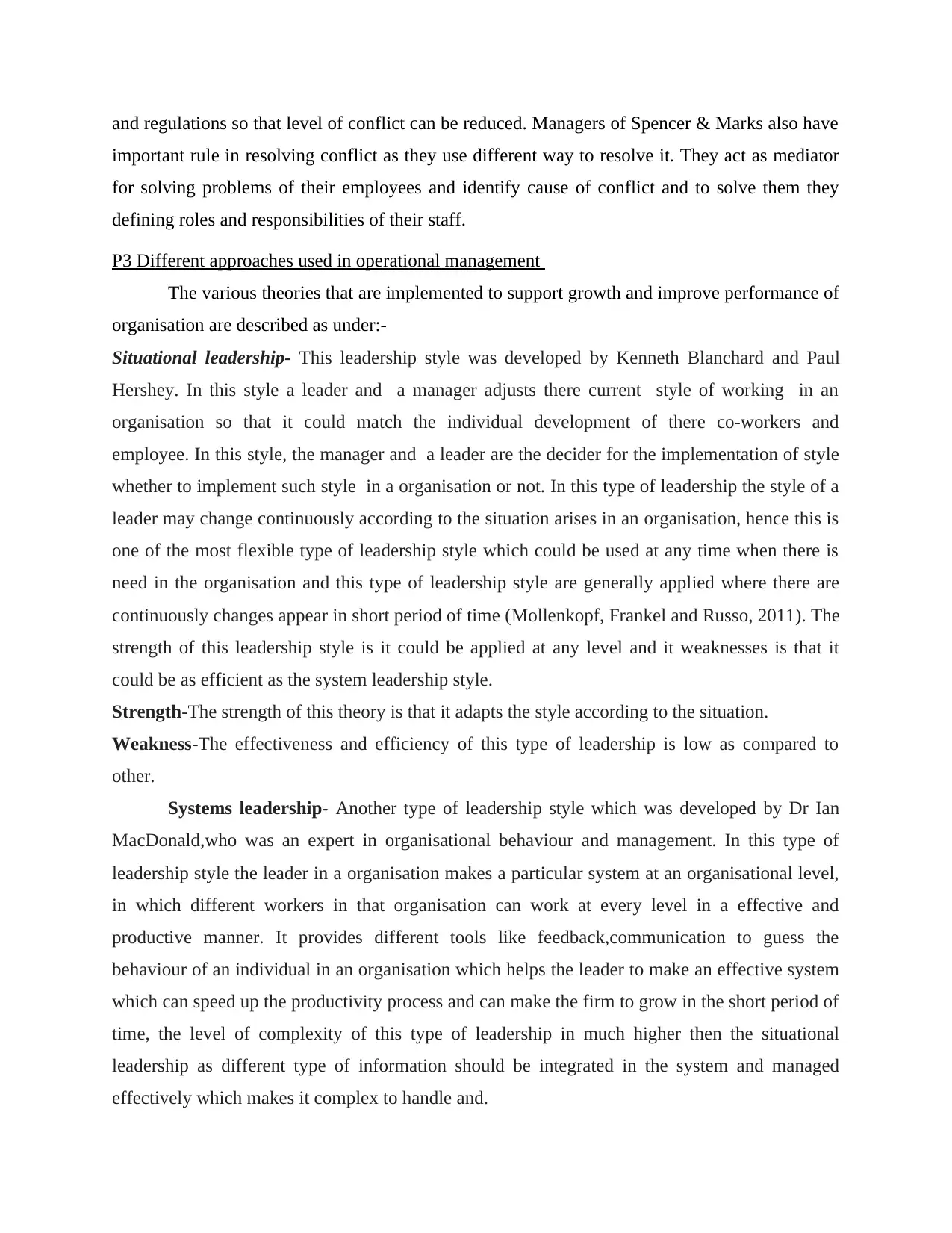
and regulations so that level of conflict can be reduced. Managers of Spencer & Marks also have
important rule in resolving conflict as they use different way to resolve it. They act as mediator
for solving problems of their employees and identify cause of conflict and to solve them they
defining roles and responsibilities of their staff.
P3 Different approaches used in operational management
The various theories that are implemented to support growth and improve performance of
organisation are described as under:-
Situational leadership- This leadership style was developed by Kenneth Blanchard and Paul
Hershey. In this style a leader and a manager adjusts there current style of working in an
organisation so that it could match the individual development of there co-workers and
employee. In this style, the manager and a leader are the decider for the implementation of style
whether to implement such style in a organisation or not. In this type of leadership the style of a
leader may change continuously according to the situation arises in an organisation, hence this is
one of the most flexible type of leadership style which could be used at any time when there is
need in the organisation and this type of leadership style are generally applied where there are
continuously changes appear in short period of time (Mollenkopf, Frankel and Russo, 2011). The
strength of this leadership style is it could be applied at any level and it weaknesses is that it
could be as efficient as the system leadership style.
Strength-The strength of this theory is that it adapts the style according to the situation.
Weakness-The effectiveness and efficiency of this type of leadership is low as compared to
other.
Systems leadership- Another type of leadership style which was developed by Dr Ian
MacDonald,who was an expert in organisational behaviour and management. In this type of
leadership style the leader in a organisation makes a particular system at an organisational level,
in which different workers in that organisation can work at every level in a effective and
productive manner. It provides different tools like feedback,communication to guess the
behaviour of an individual in an organisation which helps the leader to make an effective system
which can speed up the productivity process and can make the firm to grow in the short period of
time, the level of complexity of this type of leadership in much higher then the situational
leadership as different type of information should be integrated in the system and managed
effectively which makes it complex to handle and.
important rule in resolving conflict as they use different way to resolve it. They act as mediator
for solving problems of their employees and identify cause of conflict and to solve them they
defining roles and responsibilities of their staff.
P3 Different approaches used in operational management
The various theories that are implemented to support growth and improve performance of
organisation are described as under:-
Situational leadership- This leadership style was developed by Kenneth Blanchard and Paul
Hershey. In this style a leader and a manager adjusts there current style of working in an
organisation so that it could match the individual development of there co-workers and
employee. In this style, the manager and a leader are the decider for the implementation of style
whether to implement such style in a organisation or not. In this type of leadership the style of a
leader may change continuously according to the situation arises in an organisation, hence this is
one of the most flexible type of leadership style which could be used at any time when there is
need in the organisation and this type of leadership style are generally applied where there are
continuously changes appear in short period of time (Mollenkopf, Frankel and Russo, 2011). The
strength of this leadership style is it could be applied at any level and it weaknesses is that it
could be as efficient as the system leadership style.
Strength-The strength of this theory is that it adapts the style according to the situation.
Weakness-The effectiveness and efficiency of this type of leadership is low as compared to
other.
Systems leadership- Another type of leadership style which was developed by Dr Ian
MacDonald,who was an expert in organisational behaviour and management. In this type of
leadership style the leader in a organisation makes a particular system at an organisational level,
in which different workers in that organisation can work at every level in a effective and
productive manner. It provides different tools like feedback,communication to guess the
behaviour of an individual in an organisation which helps the leader to make an effective system
which can speed up the productivity process and can make the firm to grow in the short period of
time, the level of complexity of this type of leadership in much higher then the situational
leadership as different type of information should be integrated in the system and managed
effectively which makes it complex to handle and.
⊘ This is a preview!⊘
Do you want full access?
Subscribe today to unlock all pages.

Trusted by 1+ million students worldwide
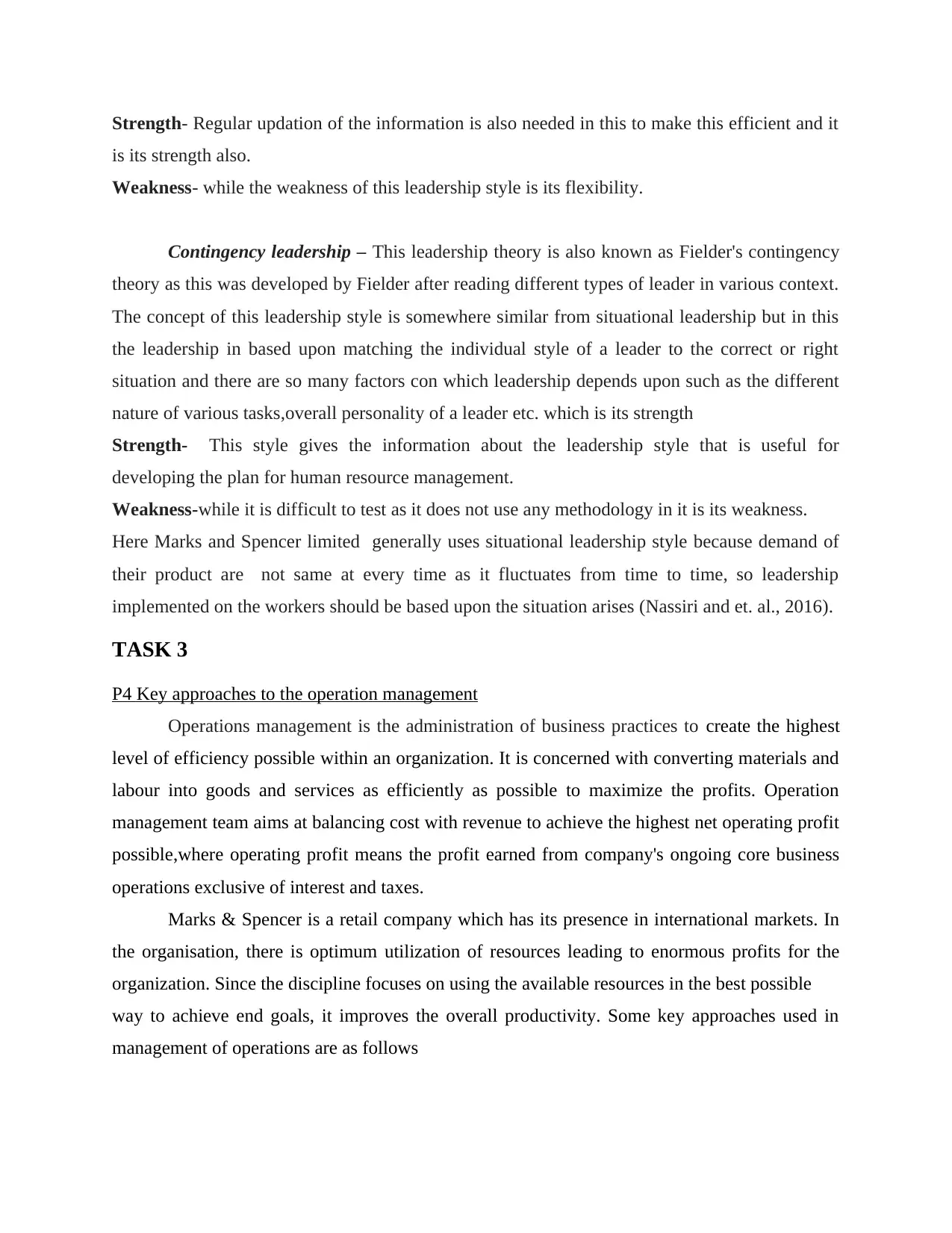
Strength- Regular updation of the information is also needed in this to make this efficient and it
is its strength also.
Weakness- while the weakness of this leadership style is its flexibility.
Contingency leadership – This leadership theory is also known as Fielder's contingency
theory as this was developed by Fielder after reading different types of leader in various context.
The concept of this leadership style is somewhere similar from situational leadership but in this
the leadership in based upon matching the individual style of a leader to the correct or right
situation and there are so many factors con which leadership depends upon such as the different
nature of various tasks,overall personality of a leader etc. which is its strength
Strength- This style gives the information about the leadership style that is useful for
developing the plan for human resource management.
Weakness-while it is difficult to test as it does not use any methodology in it is its weakness.
Here Marks and Spencer limited generally uses situational leadership style because demand of
their product are not same at every time as it fluctuates from time to time, so leadership
implemented on the workers should be based upon the situation arises (Nassiri and et. al., 2016).
TASK 3
P4 Key approaches to the operation management
Operations management is the administration of business practices to create the highest
level of efficiency possible within an organization. It is concerned with converting materials and
labour into goods and services as efficiently as possible to maximize the profits. Operation
management team aims at balancing cost with revenue to achieve the highest net operating profit
possible,where operating profit means the profit earned from company's ongoing core business
operations exclusive of interest and taxes.
Marks & Spencer is a retail company which has its presence in international markets. In
the organisation, there is optimum utilization of resources leading to enormous profits for the
organization. Since the discipline focuses on using the available resources in the best possible
way to achieve end goals, it improves the overall productivity. Some key approaches used in
management of operations are as follows
is its strength also.
Weakness- while the weakness of this leadership style is its flexibility.
Contingency leadership – This leadership theory is also known as Fielder's contingency
theory as this was developed by Fielder after reading different types of leader in various context.
The concept of this leadership style is somewhere similar from situational leadership but in this
the leadership in based upon matching the individual style of a leader to the correct or right
situation and there are so many factors con which leadership depends upon such as the different
nature of various tasks,overall personality of a leader etc. which is its strength
Strength- This style gives the information about the leadership style that is useful for
developing the plan for human resource management.
Weakness-while it is difficult to test as it does not use any methodology in it is its weakness.
Here Marks and Spencer limited generally uses situational leadership style because demand of
their product are not same at every time as it fluctuates from time to time, so leadership
implemented on the workers should be based upon the situation arises (Nassiri and et. al., 2016).
TASK 3
P4 Key approaches to the operation management
Operations management is the administration of business practices to create the highest
level of efficiency possible within an organization. It is concerned with converting materials and
labour into goods and services as efficiently as possible to maximize the profits. Operation
management team aims at balancing cost with revenue to achieve the highest net operating profit
possible,where operating profit means the profit earned from company's ongoing core business
operations exclusive of interest and taxes.
Marks & Spencer is a retail company which has its presence in international markets. In
the organisation, there is optimum utilization of resources leading to enormous profits for the
organization. Since the discipline focuses on using the available resources in the best possible
way to achieve end goals, it improves the overall productivity. Some key approaches used in
management of operations are as follows
Paraphrase This Document
Need a fresh take? Get an instant paraphrase of this document with our AI Paraphraser
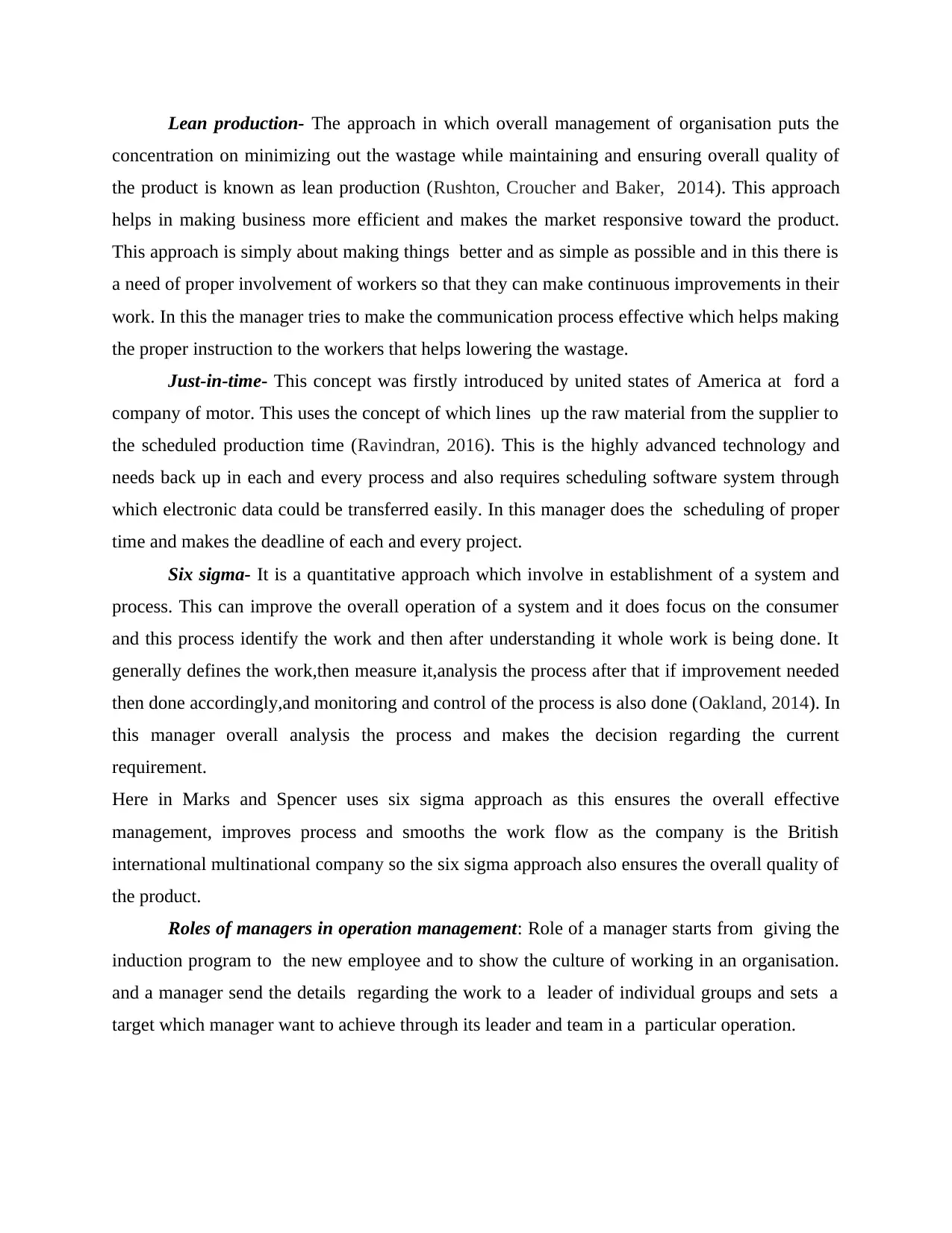
Lean production- The approach in which overall management of organisation puts the
concentration on minimizing out the wastage while maintaining and ensuring overall quality of
the product is known as lean production (Rushton, Croucher and Baker, 2014). This approach
helps in making business more efficient and makes the market responsive toward the product.
This approach is simply about making things better and as simple as possible and in this there is
a need of proper involvement of workers so that they can make continuous improvements in their
work. In this the manager tries to make the communication process effective which helps making
the proper instruction to the workers that helps lowering the wastage.
Just-in-time- This concept was firstly introduced by united states of America at ford a
company of motor. This uses the concept of which lines up the raw material from the supplier to
the scheduled production time (Ravindran, 2016). This is the highly advanced technology and
needs back up in each and every process and also requires scheduling software system through
which electronic data could be transferred easily. In this manager does the scheduling of proper
time and makes the deadline of each and every project.
Six sigma- It is a quantitative approach which involve in establishment of a system and
process. This can improve the overall operation of a system and it does focus on the consumer
and this process identify the work and then after understanding it whole work is being done. It
generally defines the work,then measure it,analysis the process after that if improvement needed
then done accordingly,and monitoring and control of the process is also done (Oakland, 2014). In
this manager overall analysis the process and makes the decision regarding the current
requirement.
Here in Marks and Spencer uses six sigma approach as this ensures the overall effective
management, improves process and smooths the work flow as the company is the British
international multinational company so the six sigma approach also ensures the overall quality of
the product.
Roles of managers in operation management: Role of a manager starts from giving the
induction program to the new employee and to show the culture of working in an organisation.
and a manager send the details regarding the work to a leader of individual groups and sets a
target which manager want to achieve through its leader and team in a particular operation.
concentration on minimizing out the wastage while maintaining and ensuring overall quality of
the product is known as lean production (Rushton, Croucher and Baker, 2014). This approach
helps in making business more efficient and makes the market responsive toward the product.
This approach is simply about making things better and as simple as possible and in this there is
a need of proper involvement of workers so that they can make continuous improvements in their
work. In this the manager tries to make the communication process effective which helps making
the proper instruction to the workers that helps lowering the wastage.
Just-in-time- This concept was firstly introduced by united states of America at ford a
company of motor. This uses the concept of which lines up the raw material from the supplier to
the scheduled production time (Ravindran, 2016). This is the highly advanced technology and
needs back up in each and every process and also requires scheduling software system through
which electronic data could be transferred easily. In this manager does the scheduling of proper
time and makes the deadline of each and every project.
Six sigma- It is a quantitative approach which involve in establishment of a system and
process. This can improve the overall operation of a system and it does focus on the consumer
and this process identify the work and then after understanding it whole work is being done. It
generally defines the work,then measure it,analysis the process after that if improvement needed
then done accordingly,and monitoring and control of the process is also done (Oakland, 2014). In
this manager overall analysis the process and makes the decision regarding the current
requirement.
Here in Marks and Spencer uses six sigma approach as this ensures the overall effective
management, improves process and smooths the work flow as the company is the British
international multinational company so the six sigma approach also ensures the overall quality of
the product.
Roles of managers in operation management: Role of a manager starts from giving the
induction program to the new employee and to show the culture of working in an organisation.
and a manager send the details regarding the work to a leader of individual groups and sets a
target which manager want to achieve through its leader and team in a particular operation.
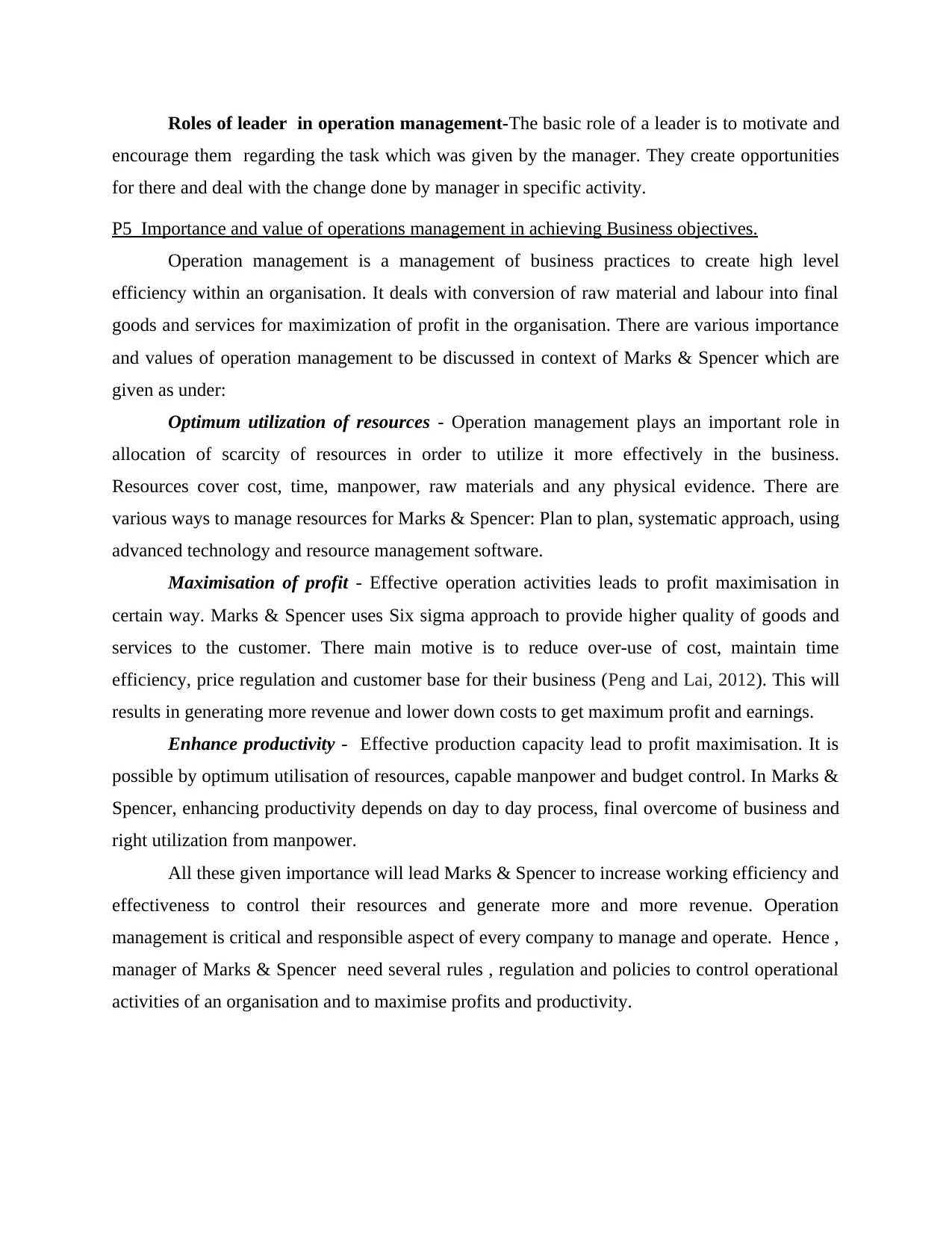
Roles of leader in operation management-The basic role of a leader is to motivate and
encourage them regarding the task which was given by the manager. They create opportunities
for there and deal with the change done by manager in specific activity.
P5 Importance and value of operations management in achieving Business objectives.
Operation management is a management of business practices to create high level
efficiency within an organisation. It deals with conversion of raw material and labour into final
goods and services for maximization of profit in the organisation. There are various importance
and values of operation management to be discussed in context of Marks & Spencer which are
given as under:
Optimum utilization of resources - Operation management plays an important role in
allocation of scarcity of resources in order to utilize it more effectively in the business.
Resources cover cost, time, manpower, raw materials and any physical evidence. There are
various ways to manage resources for Marks & Spencer: Plan to plan, systematic approach, using
advanced technology and resource management software.
Maximisation of profit - Effective operation activities leads to profit maximisation in
certain way. Marks & Spencer uses Six sigma approach to provide higher quality of goods and
services to the customer. There main motive is to reduce over-use of cost, maintain time
efficiency, price regulation and customer base for their business (Peng and Lai, 2012). This will
results in generating more revenue and lower down costs to get maximum profit and earnings.
Enhance productivity - Effective production capacity lead to profit maximisation. It is
possible by optimum utilisation of resources, capable manpower and budget control. In Marks &
Spencer, enhancing productivity depends on day to day process, final overcome of business and
right utilization from manpower.
All these given importance will lead Marks & Spencer to increase working efficiency and
effectiveness to control their resources and generate more and more revenue. Operation
management is critical and responsible aspect of every company to manage and operate. Hence ,
manager of Marks & Spencer need several rules , regulation and policies to control operational
activities of an organisation and to maximise profits and productivity.
encourage them regarding the task which was given by the manager. They create opportunities
for there and deal with the change done by manager in specific activity.
P5 Importance and value of operations management in achieving Business objectives.
Operation management is a management of business practices to create high level
efficiency within an organisation. It deals with conversion of raw material and labour into final
goods and services for maximization of profit in the organisation. There are various importance
and values of operation management to be discussed in context of Marks & Spencer which are
given as under:
Optimum utilization of resources - Operation management plays an important role in
allocation of scarcity of resources in order to utilize it more effectively in the business.
Resources cover cost, time, manpower, raw materials and any physical evidence. There are
various ways to manage resources for Marks & Spencer: Plan to plan, systematic approach, using
advanced technology and resource management software.
Maximisation of profit - Effective operation activities leads to profit maximisation in
certain way. Marks & Spencer uses Six sigma approach to provide higher quality of goods and
services to the customer. There main motive is to reduce over-use of cost, maintain time
efficiency, price regulation and customer base for their business (Peng and Lai, 2012). This will
results in generating more revenue and lower down costs to get maximum profit and earnings.
Enhance productivity - Effective production capacity lead to profit maximisation. It is
possible by optimum utilisation of resources, capable manpower and budget control. In Marks &
Spencer, enhancing productivity depends on day to day process, final overcome of business and
right utilization from manpower.
All these given importance will lead Marks & Spencer to increase working efficiency and
effectiveness to control their resources and generate more and more revenue. Operation
management is critical and responsible aspect of every company to manage and operate. Hence ,
manager of Marks & Spencer need several rules , regulation and policies to control operational
activities of an organisation and to maximise profits and productivity.
⊘ This is a preview!⊘
Do you want full access?
Subscribe today to unlock all pages.

Trusted by 1+ million students worldwide
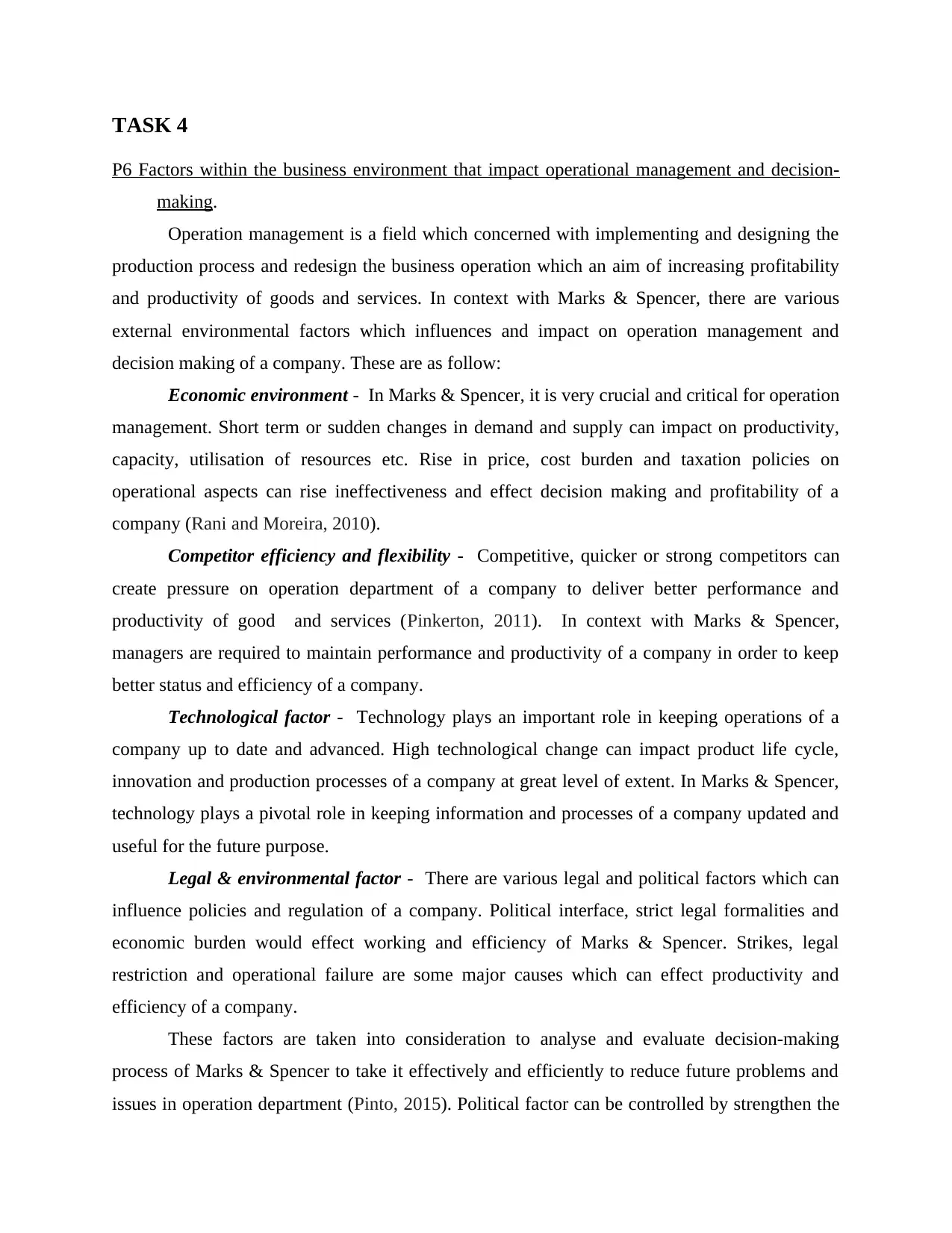
TASK 4
P6 Factors within the business environment that impact operational management and decision-
making.
Operation management is a field which concerned with implementing and designing the
production process and redesign the business operation which an aim of increasing profitability
and productivity of goods and services. In context with Marks & Spencer, there are various
external environmental factors which influences and impact on operation management and
decision making of a company. These are as follow:
Economic environment - In Marks & Spencer, it is very crucial and critical for operation
management. Short term or sudden changes in demand and supply can impact on productivity,
capacity, utilisation of resources etc. Rise in price, cost burden and taxation policies on
operational aspects can rise ineffectiveness and effect decision making and profitability of a
company (Rani and Moreira, 2010).
Competitor efficiency and flexibility - Competitive, quicker or strong competitors can
create pressure on operation department of a company to deliver better performance and
productivity of good and services (Pinkerton, 2011). In context with Marks & Spencer,
managers are required to maintain performance and productivity of a company in order to keep
better status and efficiency of a company.
Technological factor - Technology plays an important role in keeping operations of a
company up to date and advanced. High technological change can impact product life cycle,
innovation and production processes of a company at great level of extent. In Marks & Spencer,
technology plays a pivotal role in keeping information and processes of a company updated and
useful for the future purpose.
Legal & environmental factor - There are various legal and political factors which can
influence policies and regulation of a company. Political interface, strict legal formalities and
economic burden would effect working and efficiency of Marks & Spencer. Strikes, legal
restriction and operational failure are some major causes which can effect productivity and
efficiency of a company.
These factors are taken into consideration to analyse and evaluate decision-making
process of Marks & Spencer to take it effectively and efficiently to reduce future problems and
issues in operation department (Pinto, 2015). Political factor can be controlled by strengthen the
P6 Factors within the business environment that impact operational management and decision-
making.
Operation management is a field which concerned with implementing and designing the
production process and redesign the business operation which an aim of increasing profitability
and productivity of goods and services. In context with Marks & Spencer, there are various
external environmental factors which influences and impact on operation management and
decision making of a company. These are as follow:
Economic environment - In Marks & Spencer, it is very crucial and critical for operation
management. Short term or sudden changes in demand and supply can impact on productivity,
capacity, utilisation of resources etc. Rise in price, cost burden and taxation policies on
operational aspects can rise ineffectiveness and effect decision making and profitability of a
company (Rani and Moreira, 2010).
Competitor efficiency and flexibility - Competitive, quicker or strong competitors can
create pressure on operation department of a company to deliver better performance and
productivity of good and services (Pinkerton, 2011). In context with Marks & Spencer,
managers are required to maintain performance and productivity of a company in order to keep
better status and efficiency of a company.
Technological factor - Technology plays an important role in keeping operations of a
company up to date and advanced. High technological change can impact product life cycle,
innovation and production processes of a company at great level of extent. In Marks & Spencer,
technology plays a pivotal role in keeping information and processes of a company updated and
useful for the future purpose.
Legal & environmental factor - There are various legal and political factors which can
influence policies and regulation of a company. Political interface, strict legal formalities and
economic burden would effect working and efficiency of Marks & Spencer. Strikes, legal
restriction and operational failure are some major causes which can effect productivity and
efficiency of a company.
These factors are taken into consideration to analyse and evaluate decision-making
process of Marks & Spencer to take it effectively and efficiently to reduce future problems and
issues in operation department (Pinto, 2015). Political factor can be controlled by strengthen the
Paraphrase This Document
Need a fresh take? Get an instant paraphrase of this document with our AI Paraphraser
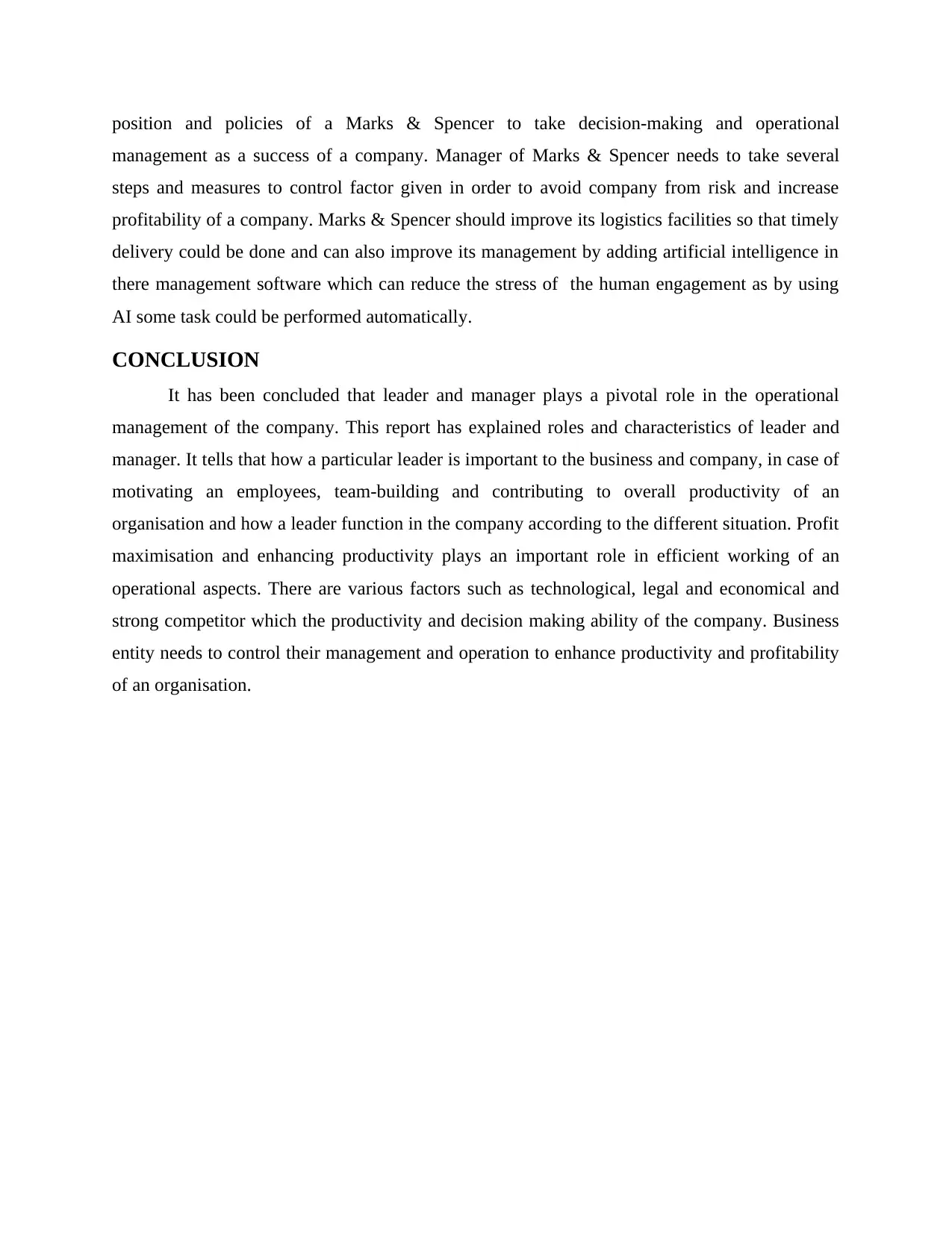
position and policies of a Marks & Spencer to take decision-making and operational
management as a success of a company. Manager of Marks & Spencer needs to take several
steps and measures to control factor given in order to avoid company from risk and increase
profitability of a company. Marks & Spencer should improve its logistics facilities so that timely
delivery could be done and can also improve its management by adding artificial intelligence in
there management software which can reduce the stress of the human engagement as by using
AI some task could be performed automatically.
CONCLUSION
It has been concluded that leader and manager plays a pivotal role in the operational
management of the company. This report has explained roles and characteristics of leader and
manager. It tells that how a particular leader is important to the business and company, in case of
motivating an employees, team-building and contributing to overall productivity of an
organisation and how a leader function in the company according to the different situation. Profit
maximisation and enhancing productivity plays an important role in efficient working of an
operational aspects. There are various factors such as technological, legal and economical and
strong competitor which the productivity and decision making ability of the company. Business
entity needs to control their management and operation to enhance productivity and profitability
of an organisation.
management as a success of a company. Manager of Marks & Spencer needs to take several
steps and measures to control factor given in order to avoid company from risk and increase
profitability of a company. Marks & Spencer should improve its logistics facilities so that timely
delivery could be done and can also improve its management by adding artificial intelligence in
there management software which can reduce the stress of the human engagement as by using
AI some task could be performed automatically.
CONCLUSION
It has been concluded that leader and manager plays a pivotal role in the operational
management of the company. This report has explained roles and characteristics of leader and
manager. It tells that how a particular leader is important to the business and company, in case of
motivating an employees, team-building and contributing to overall productivity of an
organisation and how a leader function in the company according to the different situation. Profit
maximisation and enhancing productivity plays an important role in efficient working of an
operational aspects. There are various factors such as technological, legal and economical and
strong competitor which the productivity and decision making ability of the company. Business
entity needs to control their management and operation to enhance productivity and profitability
of an organisation.
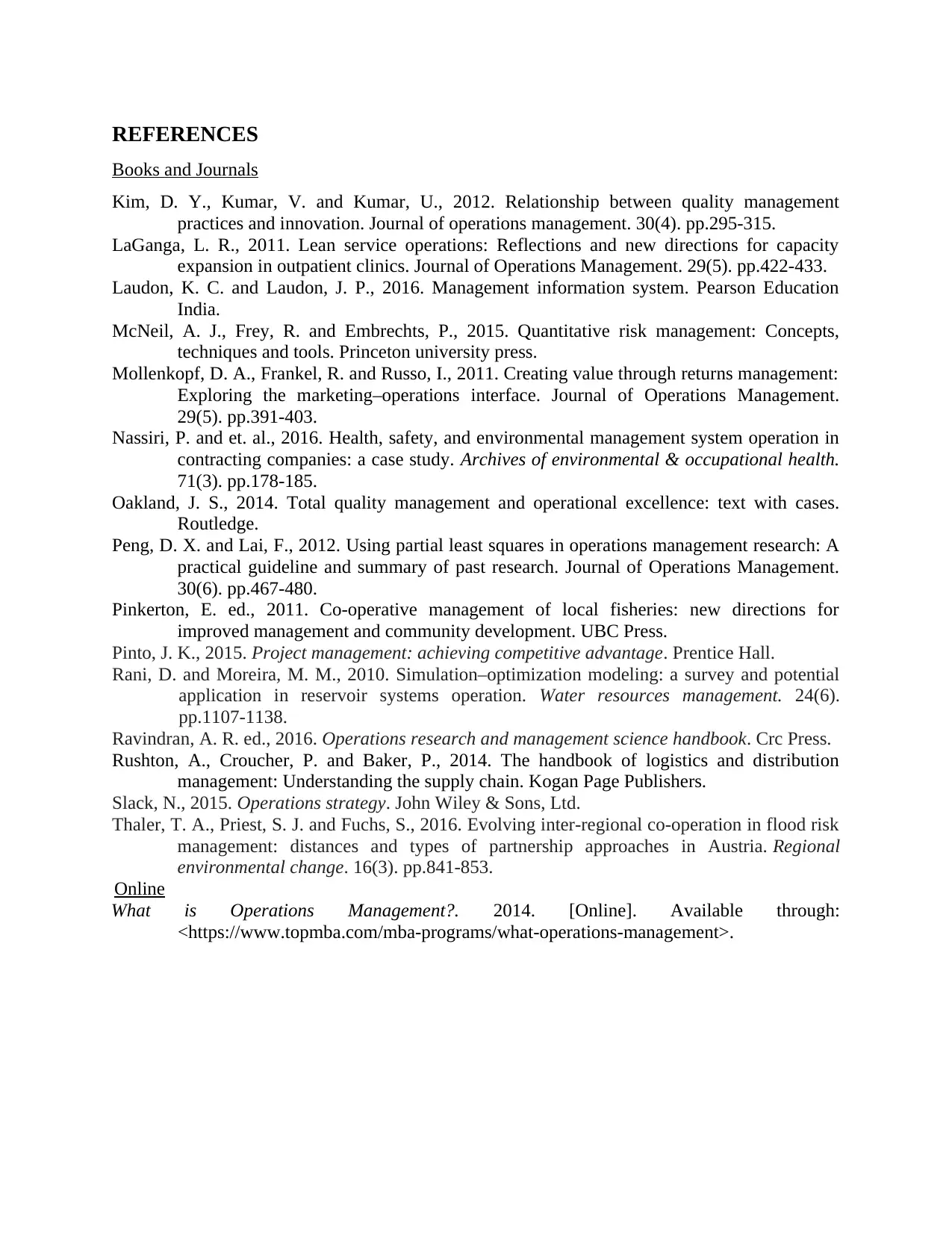
REFERENCES
Books and Journals
Kim, D. Y., Kumar, V. and Kumar, U., 2012. Relationship between quality management
practices and innovation. Journal of operations management. 30(4). pp.295-315.
LaGanga, L. R., 2011. Lean service operations: Reflections and new directions for capacity
expansion in outpatient clinics. Journal of Operations Management. 29(5). pp.422-433.
Laudon, K. C. and Laudon, J. P., 2016. Management information system. Pearson Education
India.
McNeil, A. J., Frey, R. and Embrechts, P., 2015. Quantitative risk management: Concepts,
techniques and tools. Princeton university press.
Mollenkopf, D. A., Frankel, R. and Russo, I., 2011. Creating value through returns management:
Exploring the marketing–operations interface. Journal of Operations Management.
29(5). pp.391-403.
Nassiri, P. and et. al., 2016. Health, safety, and environmental management system operation in
contracting companies: a case study. Archives of environmental & occupational health.
71(3). pp.178-185.
Oakland, J. S., 2014. Total quality management and operational excellence: text with cases.
Routledge.
Peng, D. X. and Lai, F., 2012. Using partial least squares in operations management research: A
practical guideline and summary of past research. Journal of Operations Management.
30(6). pp.467-480.
Pinkerton, E. ed., 2011. Co-operative management of local fisheries: new directions for
improved management and community development. UBC Press.
Pinto, J. K., 2015. Project management: achieving competitive advantage. Prentice Hall.
Rani, D. and Moreira, M. M., 2010. Simulation–optimization modeling: a survey and potential
application in reservoir systems operation. Water resources management. 24(6).
pp.1107-1138.
Ravindran, A. R. ed., 2016. Operations research and management science handbook. Crc Press.
Rushton, A., Croucher, P. and Baker, P., 2014. The handbook of logistics and distribution
management: Understanding the supply chain. Kogan Page Publishers.
Slack, N., 2015. Operations strategy. John Wiley & Sons, Ltd.
Thaler, T. A., Priest, S. J. and Fuchs, S., 2016. Evolving inter-regional co-operation in flood risk
management: distances and types of partnership approaches in Austria. Regional
environmental change. 16(3). pp.841-853.
Online
What is Operations Management?. 2014. [Online]. Available through:
<https://www.topmba.com/mba-programs/what-operations-management>.
Books and Journals
Kim, D. Y., Kumar, V. and Kumar, U., 2012. Relationship between quality management
practices and innovation. Journal of operations management. 30(4). pp.295-315.
LaGanga, L. R., 2011. Lean service operations: Reflections and new directions for capacity
expansion in outpatient clinics. Journal of Operations Management. 29(5). pp.422-433.
Laudon, K. C. and Laudon, J. P., 2016. Management information system. Pearson Education
India.
McNeil, A. J., Frey, R. and Embrechts, P., 2015. Quantitative risk management: Concepts,
techniques and tools. Princeton university press.
Mollenkopf, D. A., Frankel, R. and Russo, I., 2011. Creating value through returns management:
Exploring the marketing–operations interface. Journal of Operations Management.
29(5). pp.391-403.
Nassiri, P. and et. al., 2016. Health, safety, and environmental management system operation in
contracting companies: a case study. Archives of environmental & occupational health.
71(3). pp.178-185.
Oakland, J. S., 2014. Total quality management and operational excellence: text with cases.
Routledge.
Peng, D. X. and Lai, F., 2012. Using partial least squares in operations management research: A
practical guideline and summary of past research. Journal of Operations Management.
30(6). pp.467-480.
Pinkerton, E. ed., 2011. Co-operative management of local fisheries: new directions for
improved management and community development. UBC Press.
Pinto, J. K., 2015. Project management: achieving competitive advantage. Prentice Hall.
Rani, D. and Moreira, M. M., 2010. Simulation–optimization modeling: a survey and potential
application in reservoir systems operation. Water resources management. 24(6).
pp.1107-1138.
Ravindran, A. R. ed., 2016. Operations research and management science handbook. Crc Press.
Rushton, A., Croucher, P. and Baker, P., 2014. The handbook of logistics and distribution
management: Understanding the supply chain. Kogan Page Publishers.
Slack, N., 2015. Operations strategy. John Wiley & Sons, Ltd.
Thaler, T. A., Priest, S. J. and Fuchs, S., 2016. Evolving inter-regional co-operation in flood risk
management: distances and types of partnership approaches in Austria. Regional
environmental change. 16(3). pp.841-853.
Online
What is Operations Management?. 2014. [Online]. Available through:
<https://www.topmba.com/mba-programs/what-operations-management>.
⊘ This is a preview!⊘
Do you want full access?
Subscribe today to unlock all pages.

Trusted by 1+ million students worldwide
1 out of 13
Related Documents
Your All-in-One AI-Powered Toolkit for Academic Success.
+13062052269
info@desklib.com
Available 24*7 on WhatsApp / Email
![[object Object]](/_next/static/media/star-bottom.7253800d.svg)
Unlock your academic potential
Copyright © 2020–2025 A2Z Services. All Rights Reserved. Developed and managed by ZUCOL.





